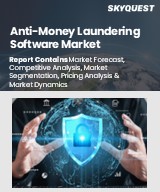
Report ID: SQMIG45A2427
Skyquest Technology's expert advisors have carried out comprehensive research on the anti-money laundering software market to identify the major global and regional market trends and growth opportunities for leading players and new entrants in this market. The analysis is based on in-depth primary and secondary research to understand the major market drivers and restraints shaping the future development and growth of the industry.
High Adoption Rate of Digital Payments
Increasing Efforts by Regulatory Agencies to Track Financial Crime
Evolving Complexity and Sophistication of Cyber Attacks
Lack of Awareness on Government Regulations and Cybersecurity
REQUEST FOR SAMPLE
Global Anti-Money Laundering Software Market size was valued at USD 3.17 Billion in 2023 and is poised to grow from USD 3.66 Billion in 2024 to USD 11.46 Billion by 2032, growing at a CAGR of 15.35% in the forecast period (2025-2032).
Key vendors in Anti-Money Laundering Software Market are: 'NICE Actimize', 'Cognizant Technology Solutions Corporation', 'Tata Consultancy Services Limited', 'SAS Institute, Inc.', 'ACI Worldwide, Inc.', 'Oracle Corporation', 'Fiserv, Inc.', 'Accenture', 'BAE Systems', 'Experian Information Solutions, Inc.', 'Open Text Corporation', 'Eastnets', 'AML Partners', 'Alessa Inc.'
Online banking and digital payments have developed tremendously in the last decade. The cashless transaction trend has been spurred by the growth of e-commerce and more online shoppers opting for electronic purchases. The increase of cashless transactions enables cyber criminals in password theft, identity theft and client’s impersonation for monetary gains. As a response to such threats, financial institutions are investing heavily in AML software packages.
Improving Regulations in the Real Estate Sector: Regulatory bodies across the globe have rolled out new regulatory measures to combat the growing risks posed by money laundering in the real estate sector. Some governments are contemplating the creation of public databases or registries that make available basic information on property and beneficial ownership. This increased transparency will discourage the use of real estate for money laundering and will enhance the market growth of anti-money laundering software.
North America is dominating with the largest anti-money laundering software market share. North America is the largest market for anti-money laundering software because of its more stringent regulations and enforcement of anti-money laundering policies. North America region has significant financial institutions that operate in a highly regulated environment, which therefore necessitates the use of more sophisticated anti-money laundering solutions. Furthermore, North America invests a lot on new technologies, including AI and machine learning which are becoming key features of modern anti-money laundering software. Additionally, the presence of developed financial institutions, together with the increasing level of financial transactions, propels the region’s dominance in the anti-money laundering software market.
Want to customize this report? This report can be personalized according to your needs. Our analysts and industry experts will work directly with you to understand your requirements and provide you with customized data in a short amount of time. We offer $1000 worth of FREE customization at the time of purchase.
Feedback From Our Clients

Report ID: SQMIG45A2427
sales@skyquestt.com
USA +1 351-333-4748